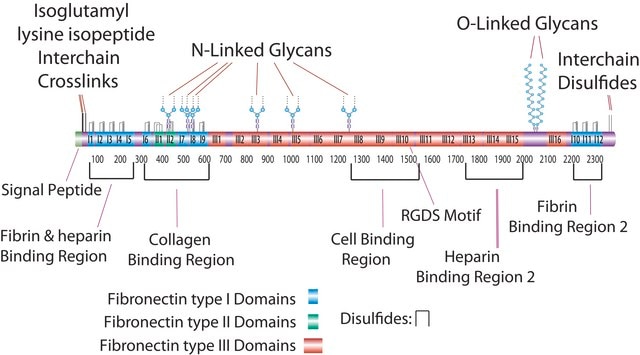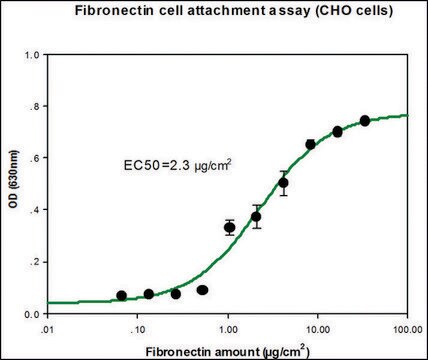F2006
Fibronectin human plasma
lyophilized powder, BioReagent, suitable for cell culture
Recommended Products
biological source
human plasma
Quality Level
sterility
sterile
product line
BioReagent
Assay
≥85% (SDS-PAGE)
form
lyophilized powder
mol wt
450 kDa
packaging
pkg of 5 x 5 mg
pkg of 1 mg
pkg of 2 mg
pkg of 5 mg
technique(s)
cell culture | mammalian: suitable
surface coverage
1‑5 μg/cm2
solubility
H2O: 1 mg/mL at 37 °C (Store reconstituted solution in working aliquots at -20°C or lower.)
UniProt accession no.
shipped in
dry ice
storage temp.
−20°C
Gene Information
human ... FN1(2335)
Looking for similar products? Visit Product Comparison Guide
Related Categories
General description
Application
- Used in cell seeding and neuronal differentiation (as one of the components in expansion medium for the re-suspension of CBSCs (Cord blood stem cells) and is also used in differentiation medium)
- Used in cell culture (the culture chamber was coated with fibronectin for the expression of HEK293 cells)
- Used in murine embroyonic stem cell line (CCE) culture and induction of endothelial cell differentiation (for the induction of endothelial cell differentiation, cultured cells were pre-coated with fibronectin)
- In-vitro fibronectin (FN) pulldown assays
- Protein specificity
- Immunofluorescence (used in staining of cell layers for membrane type-1 matrix metalloproteinase (MT1-MMP) for coating of slides)
- Extracellular matrix binding assay
- Used in cell migration study
Biochem/physiol Actions
Caution
Preparation Note
Storage Class Code
11 - Combustible Solids
WGK
WGK 3
Flash Point(F)
Not applicable
Flash Point(C)
Not applicable
Personal Protective Equipment
Regulatory Information
Certificates of Analysis (COA)
Search for Certificates of Analysis (COA) by entering the products Lot/Batch Number. Lot and Batch Numbers can be found on a product’s label following the words ‘Lot’ or ‘Batch’.
Already Own This Product?
Documents related to the products that you have purchased in the past have been gathered in the Document Library for your convenience.
Difficulty Finding Your Product Or Lot/Batch Number?
How to Find the Product Number
Product numbers are combined with Pack Sizes/Quantity when displayed on the website (example: T1503-25G). Please make sure you enter ONLY the product number in the Product Number field (example: T1503).
Example:
Additional examples:
705578-5MG-PW
PL860-CGA/SHF-1EA
MMYOMAG-74K-13
1000309185
enter as 1.000309185)
Having trouble? Feel free to contact Technical Service for assistance.
How to Find a Lot/Batch Number for COA
Lot and Batch Numbers can be found on a product's label following the words 'Lot' or 'Batch'.
Aldrich Products
For a lot number such as TO09019TO, enter it as 09019TO (without the first two letters 'TO').
For a lot number with a filling-code such as 05427ES-021, enter it as 05427ES (without the filling-code '-021').
For a lot number with a filling-code such as STBB0728K9, enter it as STBB0728 without the filling-code 'K9'.
Not Finding What You Are Looking For?
In some cases, a COA may not be available online. If your search was unable to find the COA you can request one.
Which document(s) contains shelf-life or expiration date information for a given product?
If available for a given product, the recommended re-test date or the expiration date can be found on the Certificate of Analysis.
How do I get lot-specific information or a Certificate of Analysis?
The lot specific COA document can be found by entering the lot number above under the "Documents" section.
How do I choose which fibronectin product to use to coat culture surfaces for cell growth?
The species source for the fibronectin used when coating culture surfaces is not important. It is the presence of the RGD binding site that is present in all fibronectins that promotes binding.
How long can I store the fibronectin solution?
The product is good for at least a year at 2-8 °C if kept sterile.
How long can I store fibronectin coated plates, etc?
Fibronectin coated cultureware can be stored for 2-4 weeks at 2-8 °C in a closed sterile container, or in sterile sealable bags.
What is the procedure for coating culture surfaces with fibronectin?
To coat culture surfaces: 1. Dilute fibronectin in sterile balanced salt solution and coat the culture surface (1-5 μg/cm2) with a minimal volume. 2. Allow to air dry for at least 45 minutes at room temperature. Excess fibronectin may be removed by aspiration, but this is not necessary.
How do I solubilized Fibronectin?
Dissolve at 1 mg/mL in water. Allow to dissolve for at least 30 minutes at 37 °C. A small amount of undissolved material may remain. This will not affect product performance.
How do I test the wells/flasks that have been coated with fibronectin?
We test the coated culture surface by culturing cells. We compare the adherence of the cells to wells that have been coated with media containing BSA (negative) and media containing 10% FBS (positive). The cell growth should be not less than 50% of the positive control and greater than 50% of the negative control.
How do I determine how much fibronectin is in solution?
As the product may contain undissolved material, the amount of fibronectin in solution can be determined by UV absorbance. The extinction coefficient for a 1% solution (10 mg/ml) is 13.5 at 280 nm.
How do I find price and availability?
There are several ways to find pricing and availability for our products. Once you log onto our website, you will find the price and availability displayed on the product detail page. You can contact any of our Customer Sales and Service offices to receive a quote. USA customers: 1-800-325-3010 or view local office numbers.
What is the Department of Transportation shipping information for this product?
Transportation information can be found in Section 14 of the product's (M)SDS.To access the shipping information for this material, use the link on the product detail page for the product.
What is the difference between Fibronection Products F2006 and F1056?
The difference between Product Nos. F2006 and F1056 is in the purity specifications and endotoxin testing. Product No. F2006 has a purity specification of ≥90% and is not tested for endotoxin contamination. Product No. F1056 has a purity specification of ≥95% and is tested for endotoxin contamination with a specification of ≤100 EU/mg.
My question is not addressed here, how can I contact Technical Service for assistance?
Ask a Scientist here.
Articles
Fibronectin (FN) is a multifunctional, extracellular plasma glycoprotein produced by hepatocytes that circulates at near micromolar concentration and assembles into extracellular matrix fibrils at cell surfaces along with locally produced cellular FN.
Attachment Factors for 3-Dimensional Cell Culture
The extracellular matrix (ECM) is secreted by cells and surrounds them in tissues.
3D cell culture overview. Learn about 2D vs 3D cell culture, advantages of 3D cell culture, and techniques available to develop 3D cell models
Protocols
Dilute fibronectin to the desired concentration. Optimum conditions for attachment are dependent on cell type and application. The typical coating concentration is 1 – 5 ug/cm2.Fibronectin coating protocol, products, and FAQs.
Our team of scientists has experience in all areas of research including Life Science, Material Science, Chemical Synthesis, Chromatography, Analytical and many others.
Contact Technical Service



